CSU Taxation Law: Income, Deductions, Fringe Benefits Assignment
VerifiedAdded on 2023/01/16
|13
|3165
|53
Homework Assignment
AI Summary
This taxation law assignment analyzes two key scenarios. The first assesses John's income from employment and the accounting firm's liability for fringe benefits tax, referencing relevant sections of the ITAA 1997 and FBTAA 1986, along with case law like Scott v FCT and Calvert v Wainwright. The second scenario examines Mechel Pty Ltd's deductions for cost of goods sold, exclusive distribution rights, and car lease expenses, applying section 8-1 and 40-880 of the ITAA 1997 and other relevant regulations. The assignment covers issues like assessable income, expense payment fringe benefits, business deductions, and capital gains tax, providing a detailed application of tax law principles to practical situations.
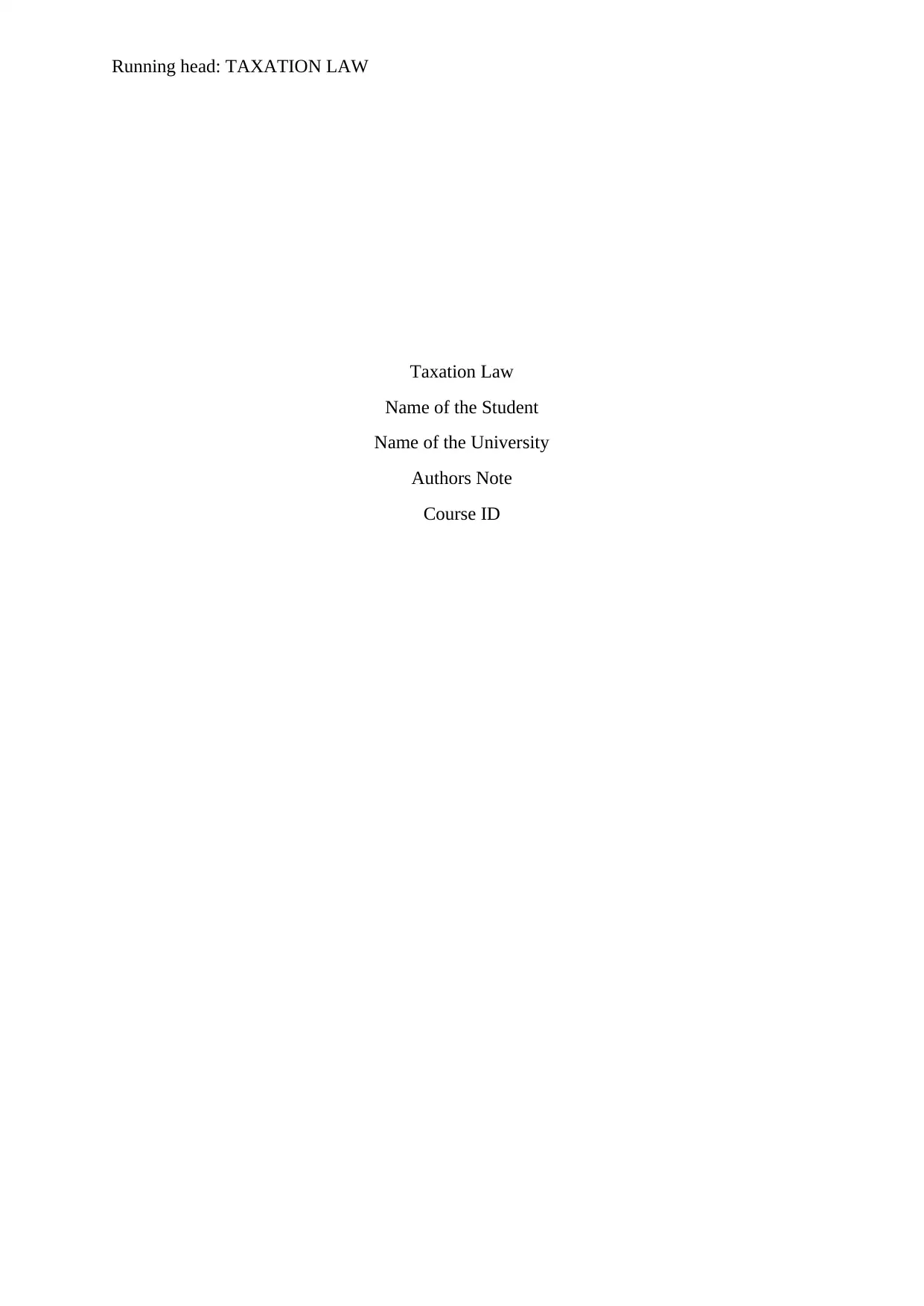
Running head: TAXATION LAW
Taxation Law
Name of the Student
Name of the University
Authors Note
Course ID
Taxation Law
Name of the Student
Name of the University
Authors Note
Course ID
Paraphrase This Document
Need a fresh take? Get an instant paraphrase of this document with our AI Paraphraser
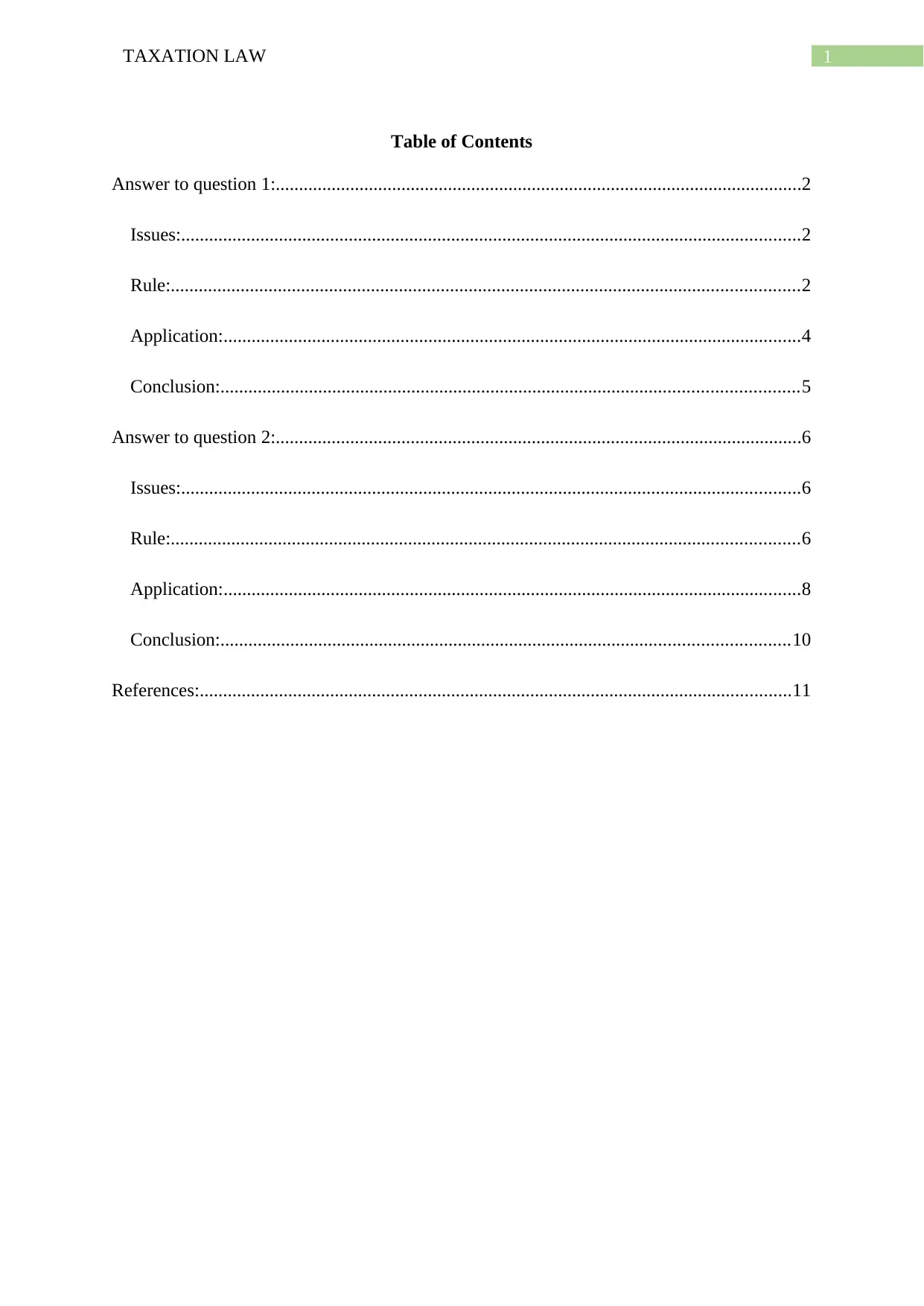
1TAXATION LAW
Table of Contents
Answer to question 1:.................................................................................................................2
Issues:.....................................................................................................................................2
Rule:.......................................................................................................................................2
Application:............................................................................................................................4
Conclusion:............................................................................................................................5
Answer to question 2:.................................................................................................................6
Issues:.....................................................................................................................................6
Rule:.......................................................................................................................................6
Application:............................................................................................................................8
Conclusion:..........................................................................................................................10
References:...............................................................................................................................11
Table of Contents
Answer to question 1:.................................................................................................................2
Issues:.....................................................................................................................................2
Rule:.......................................................................................................................................2
Application:............................................................................................................................4
Conclusion:............................................................................................................................5
Answer to question 2:.................................................................................................................6
Issues:.....................................................................................................................................6
Rule:.......................................................................................................................................6
Application:............................................................................................................................8
Conclusion:..........................................................................................................................10
References:...............................................................................................................................11
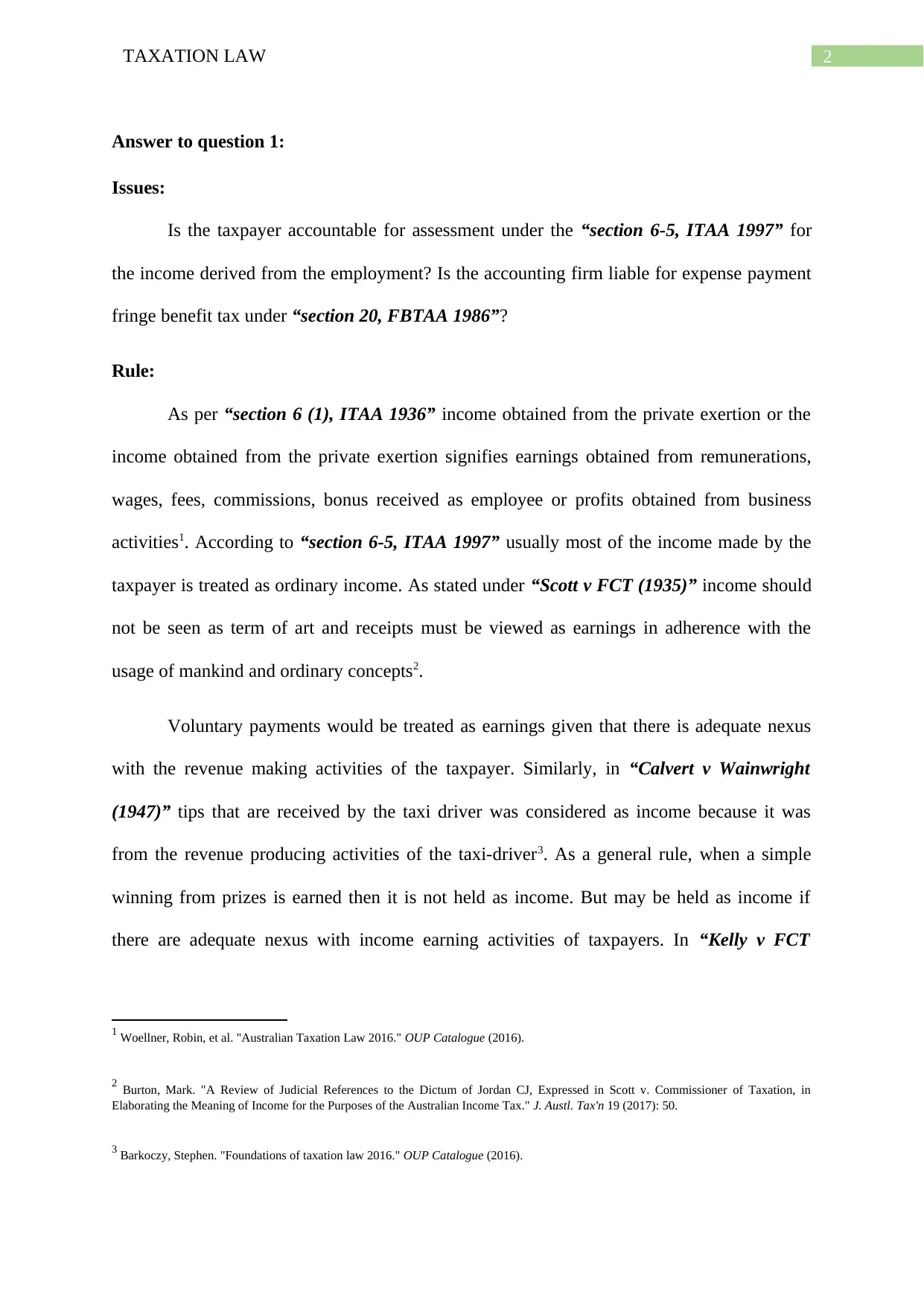
2TAXATION LAW
Answer to question 1:
Issues:
Is the taxpayer accountable for assessment under the “section 6-5, ITAA 1997” for
the income derived from the employment? Is the accounting firm liable for expense payment
fringe benefit tax under “section 20, FBTAA 1986”?
Rule:
As per “section 6 (1), ITAA 1936” income obtained from the private exertion or the
income obtained from the private exertion signifies earnings obtained from remunerations,
wages, fees, commissions, bonus received as employee or profits obtained from business
activities1. According to “section 6-5, ITAA 1997” usually most of the income made by the
taxpayer is treated as ordinary income. As stated under “Scott v FCT (1935)” income should
not be seen as term of art and receipts must be viewed as earnings in adherence with the
usage of mankind and ordinary concepts2.
Voluntary payments would be treated as earnings given that there is adequate nexus
with the revenue making activities of the taxpayer. Similarly, in “Calvert v Wainwright
(1947)” tips that are received by the taxi driver was considered as income because it was
from the revenue producing activities of the taxi-driver3. As a general rule, when a simple
winning from prizes is earned then it is not held as income. But may be held as income if
there are adequate nexus with income earning activities of taxpayers. In “Kelly v FCT
1 Woellner, Robin, et al. "Australian Taxation Law 2016." OUP Catalogue (2016).
2 Burton, Mark. "A Review of Judicial References to the Dictum of Jordan CJ, Expressed in Scott v. Commissioner of Taxation, in
Elaborating the Meaning of Income for the Purposes of the Australian Income Tax." J. Austl. Tax'n 19 (2017): 50.
3 Barkoczy, Stephen. "Foundations of taxation law 2016." OUP Catalogue (2016).
Answer to question 1:
Issues:
Is the taxpayer accountable for assessment under the “section 6-5, ITAA 1997” for
the income derived from the employment? Is the accounting firm liable for expense payment
fringe benefit tax under “section 20, FBTAA 1986”?
Rule:
As per “section 6 (1), ITAA 1936” income obtained from the private exertion or the
income obtained from the private exertion signifies earnings obtained from remunerations,
wages, fees, commissions, bonus received as employee or profits obtained from business
activities1. According to “section 6-5, ITAA 1997” usually most of the income made by the
taxpayer is treated as ordinary income. As stated under “Scott v FCT (1935)” income should
not be seen as term of art and receipts must be viewed as earnings in adherence with the
usage of mankind and ordinary concepts2.
Voluntary payments would be treated as earnings given that there is adequate nexus
with the revenue making activities of the taxpayer. Similarly, in “Calvert v Wainwright
(1947)” tips that are received by the taxi driver was considered as income because it was
from the revenue producing activities of the taxi-driver3. As a general rule, when a simple
winning from prizes is earned then it is not held as income. But may be held as income if
there are adequate nexus with income earning activities of taxpayers. In “Kelly v FCT
1 Woellner, Robin, et al. "Australian Taxation Law 2016." OUP Catalogue (2016).
2 Burton, Mark. "A Review of Judicial References to the Dictum of Jordan CJ, Expressed in Scott v. Commissioner of Taxation, in
Elaborating the Meaning of Income for the Purposes of the Australian Income Tax." J. Austl. Tax'n 19 (2017): 50.
3 Barkoczy, Stephen. "Foundations of taxation law 2016." OUP Catalogue (2016).
⊘ This is a preview!⊘
Do you want full access?
Subscribe today to unlock all pages.

Trusted by 1+ million students worldwide
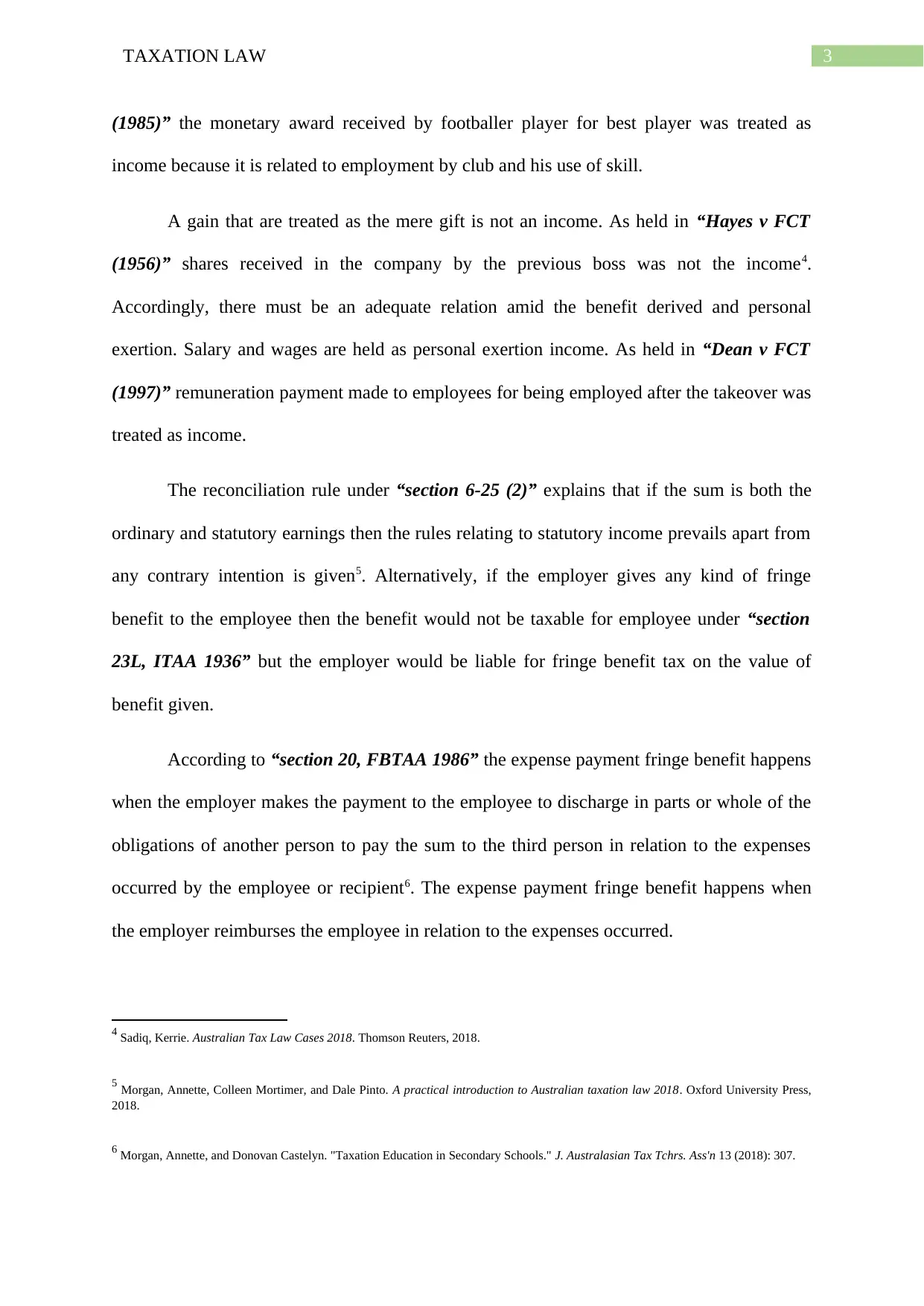
3TAXATION LAW
(1985)” the monetary award received by footballer player for best player was treated as
income because it is related to employment by club and his use of skill.
A gain that are treated as the mere gift is not an income. As held in “Hayes v FCT
(1956)” shares received in the company by the previous boss was not the income4.
Accordingly, there must be an adequate relation amid the benefit derived and personal
exertion. Salary and wages are held as personal exertion income. As held in “Dean v FCT
(1997)” remuneration payment made to employees for being employed after the takeover was
treated as income.
The reconciliation rule under “section 6-25 (2)” explains that if the sum is both the
ordinary and statutory earnings then the rules relating to statutory income prevails apart from
any contrary intention is given5. Alternatively, if the employer gives any kind of fringe
benefit to the employee then the benefit would not be taxable for employee under “section
23L, ITAA 1936” but the employer would be liable for fringe benefit tax on the value of
benefit given.
According to “section 20, FBTAA 1986” the expense payment fringe benefit happens
when the employer makes the payment to the employee to discharge in parts or whole of the
obligations of another person to pay the sum to the third person in relation to the expenses
occurred by the employee or recipient6. The expense payment fringe benefit happens when
the employer reimburses the employee in relation to the expenses occurred.
4 Sadiq, Kerrie. Australian Tax Law Cases 2018. Thomson Reuters, 2018.
5 Morgan, Annette, Colleen Mortimer, and Dale Pinto. A practical introduction to Australian taxation law 2018. Oxford University Press,
2018.
6 Morgan, Annette, and Donovan Castelyn. "Taxation Education in Secondary Schools." J. Australasian Tax Tchrs. Ass'n 13 (2018): 307.
(1985)” the monetary award received by footballer player for best player was treated as
income because it is related to employment by club and his use of skill.
A gain that are treated as the mere gift is not an income. As held in “Hayes v FCT
(1956)” shares received in the company by the previous boss was not the income4.
Accordingly, there must be an adequate relation amid the benefit derived and personal
exertion. Salary and wages are held as personal exertion income. As held in “Dean v FCT
(1997)” remuneration payment made to employees for being employed after the takeover was
treated as income.
The reconciliation rule under “section 6-25 (2)” explains that if the sum is both the
ordinary and statutory earnings then the rules relating to statutory income prevails apart from
any contrary intention is given5. Alternatively, if the employer gives any kind of fringe
benefit to the employee then the benefit would not be taxable for employee under “section
23L, ITAA 1936” but the employer would be liable for fringe benefit tax on the value of
benefit given.
According to “section 20, FBTAA 1986” the expense payment fringe benefit happens
when the employer makes the payment to the employee to discharge in parts or whole of the
obligations of another person to pay the sum to the third person in relation to the expenses
occurred by the employee or recipient6. The expense payment fringe benefit happens when
the employer reimburses the employee in relation to the expenses occurred.
4 Sadiq, Kerrie. Australian Tax Law Cases 2018. Thomson Reuters, 2018.
5 Morgan, Annette, Colleen Mortimer, and Dale Pinto. A practical introduction to Australian taxation law 2018. Oxford University Press,
2018.
6 Morgan, Annette, and Donovan Castelyn. "Taxation Education in Secondary Schools." J. Australasian Tax Tchrs. Ass'n 13 (2018): 307.
Paraphrase This Document
Need a fresh take? Get an instant paraphrase of this document with our AI Paraphraser
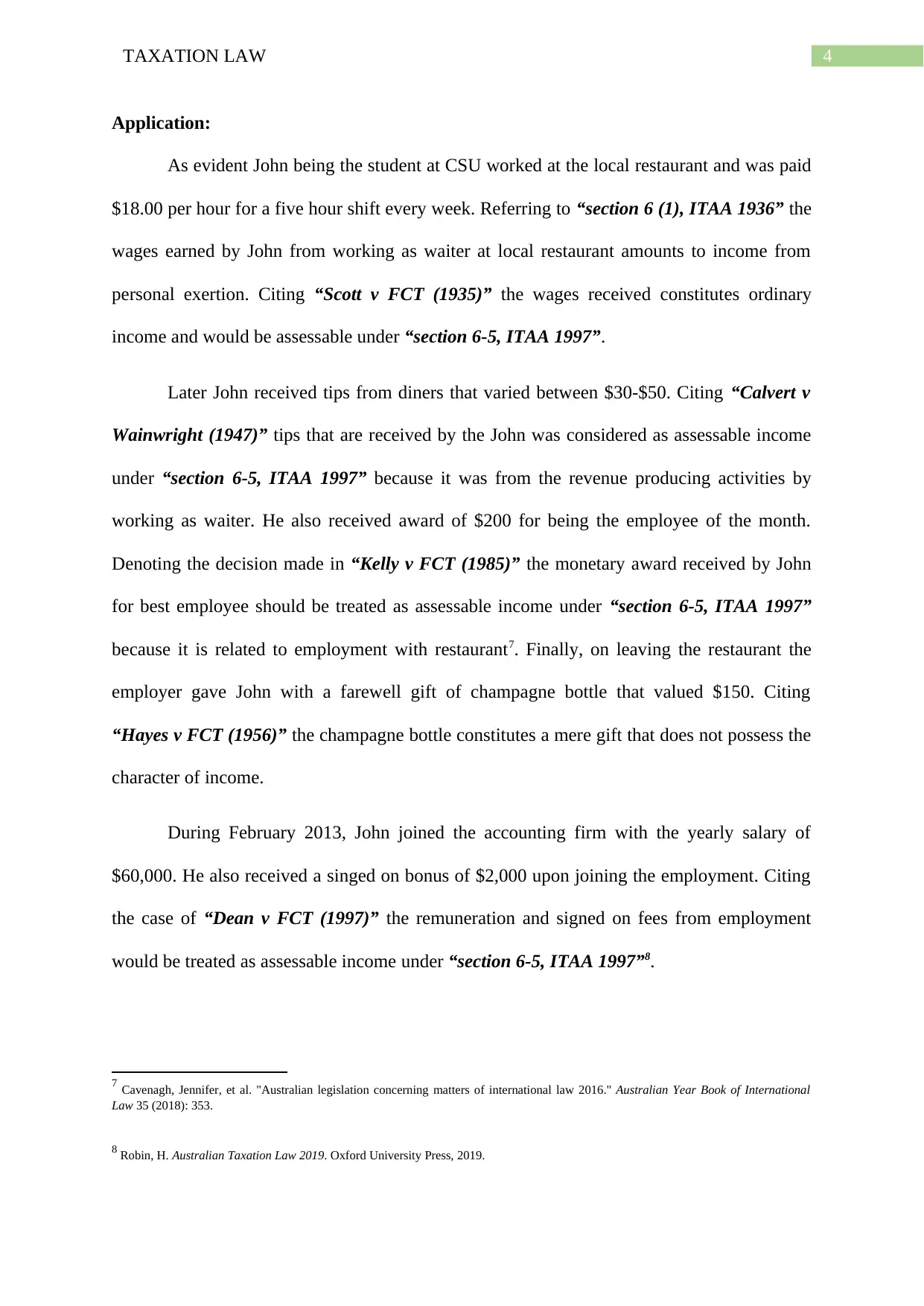
4TAXATION LAW
Application:
As evident John being the student at CSU worked at the local restaurant and was paid
$18.00 per hour for a five hour shift every week. Referring to “section 6 (1), ITAA 1936” the
wages earned by John from working as waiter at local restaurant amounts to income from
personal exertion. Citing “Scott v FCT (1935)” the wages received constitutes ordinary
income and would be assessable under “section 6-5, ITAA 1997”.
Later John received tips from diners that varied between $30-$50. Citing “Calvert v
Wainwright (1947)” tips that are received by the John was considered as assessable income
under “section 6-5, ITAA 1997” because it was from the revenue producing activities by
working as waiter. He also received award of $200 for being the employee of the month.
Denoting the decision made in “Kelly v FCT (1985)” the monetary award received by John
for best employee should be treated as assessable income under “section 6-5, ITAA 1997”
because it is related to employment with restaurant7. Finally, on leaving the restaurant the
employer gave John with a farewell gift of champagne bottle that valued $150. Citing
“Hayes v FCT (1956)” the champagne bottle constitutes a mere gift that does not possess the
character of income.
During February 2013, John joined the accounting firm with the yearly salary of
$60,000. He also received a singed on bonus of $2,000 upon joining the employment. Citing
the case of “Dean v FCT (1997)” the remuneration and signed on fees from employment
would be treated as assessable income under “section 6-5, ITAA 1997”8.
7 Cavenagh, Jennifer, et al. "Australian legislation concerning matters of international law 2016." Australian Year Book of International
Law 35 (2018): 353.
8 Robin, H. Australian Taxation Law 2019. Oxford University Press, 2019.
Application:
As evident John being the student at CSU worked at the local restaurant and was paid
$18.00 per hour for a five hour shift every week. Referring to “section 6 (1), ITAA 1936” the
wages earned by John from working as waiter at local restaurant amounts to income from
personal exertion. Citing “Scott v FCT (1935)” the wages received constitutes ordinary
income and would be assessable under “section 6-5, ITAA 1997”.
Later John received tips from diners that varied between $30-$50. Citing “Calvert v
Wainwright (1947)” tips that are received by the John was considered as assessable income
under “section 6-5, ITAA 1997” because it was from the revenue producing activities by
working as waiter. He also received award of $200 for being the employee of the month.
Denoting the decision made in “Kelly v FCT (1985)” the monetary award received by John
for best employee should be treated as assessable income under “section 6-5, ITAA 1997”
because it is related to employment with restaurant7. Finally, on leaving the restaurant the
employer gave John with a farewell gift of champagne bottle that valued $150. Citing
“Hayes v FCT (1956)” the champagne bottle constitutes a mere gift that does not possess the
character of income.
During February 2013, John joined the accounting firm with the yearly salary of
$60,000. He also received a singed on bonus of $2,000 upon joining the employment. Citing
the case of “Dean v FCT (1997)” the remuneration and signed on fees from employment
would be treated as assessable income under “section 6-5, ITAA 1997”8.
7 Cavenagh, Jennifer, et al. "Australian legislation concerning matters of international law 2016." Australian Year Book of International
Law 35 (2018): 353.
8 Robin, H. Australian Taxation Law 2019. Oxford University Press, 2019.
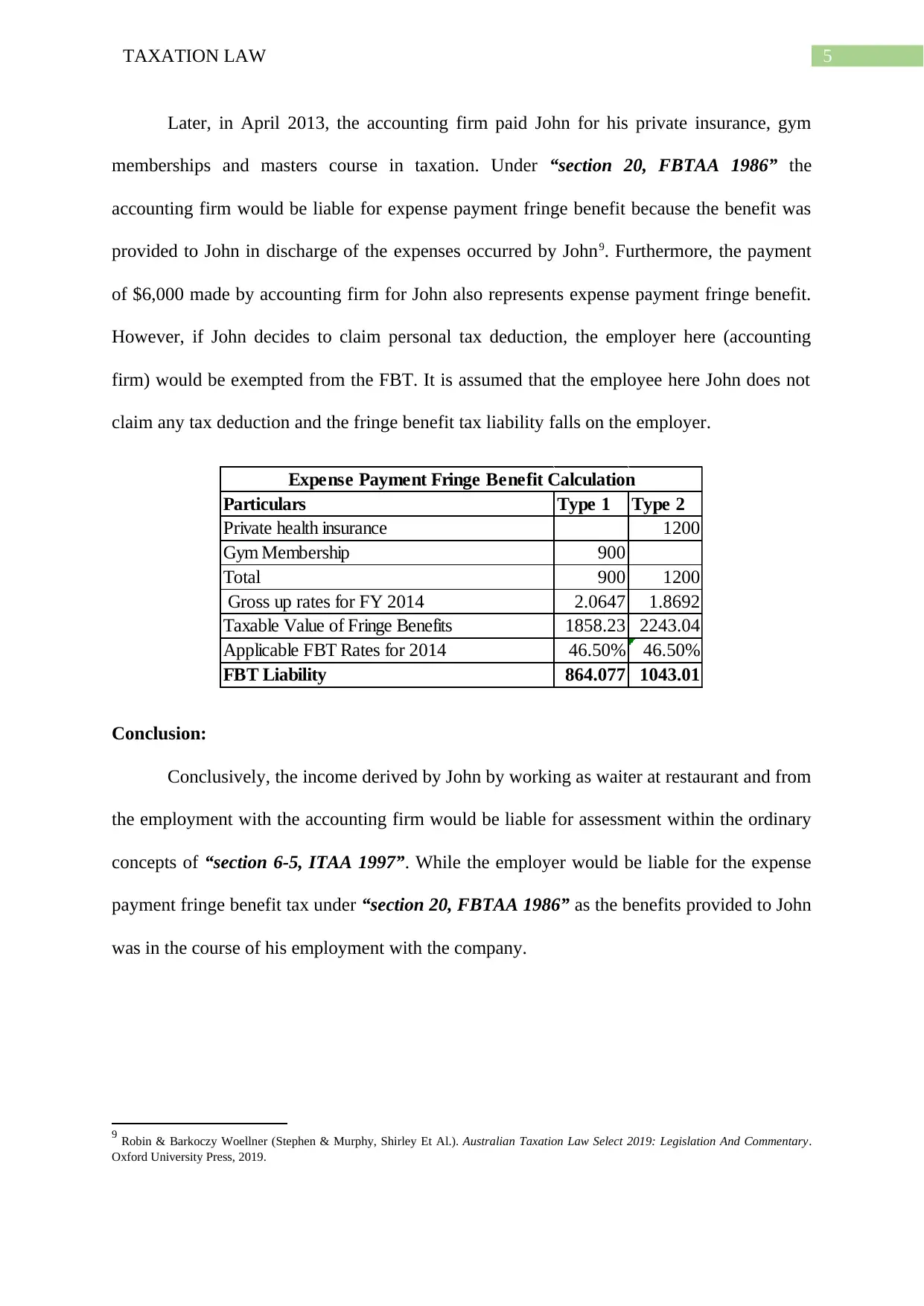
5TAXATION LAW
Later, in April 2013, the accounting firm paid John for his private insurance, gym
memberships and masters course in taxation. Under “section 20, FBTAA 1986” the
accounting firm would be liable for expense payment fringe benefit because the benefit was
provided to John in discharge of the expenses occurred by John9. Furthermore, the payment
of $6,000 made by accounting firm for John also represents expense payment fringe benefit.
However, if John decides to claim personal tax deduction, the employer here (accounting
firm) would be exempted from the FBT. It is assumed that the employee here John does not
claim any tax deduction and the fringe benefit tax liability falls on the employer.
Particulars Type 1 Type 2
Private health insurance 1200
Gym Membership 900
Total 900 1200
Gross up rates for FY 2014 2.0647 1.8692
Taxable Value of Fringe Benefits 1858.23 2243.04
Applicable FBT Rates for 2014 46.50% 46.50%
FBT Liability 864.077 1043.01
Expense Payment Fringe Benefit Calculation
Conclusion:
Conclusively, the income derived by John by working as waiter at restaurant and from
the employment with the accounting firm would be liable for assessment within the ordinary
concepts of “section 6-5, ITAA 1997”. While the employer would be liable for the expense
payment fringe benefit tax under “section 20, FBTAA 1986” as the benefits provided to John
was in the course of his employment with the company.
9 Robin & Barkoczy Woellner (Stephen & Murphy, Shirley Et Al.). Australian Taxation Law Select 2019: Legislation And Commentary.
Oxford University Press, 2019.
Later, in April 2013, the accounting firm paid John for his private insurance, gym
memberships and masters course in taxation. Under “section 20, FBTAA 1986” the
accounting firm would be liable for expense payment fringe benefit because the benefit was
provided to John in discharge of the expenses occurred by John9. Furthermore, the payment
of $6,000 made by accounting firm for John also represents expense payment fringe benefit.
However, if John decides to claim personal tax deduction, the employer here (accounting
firm) would be exempted from the FBT. It is assumed that the employee here John does not
claim any tax deduction and the fringe benefit tax liability falls on the employer.
Particulars Type 1 Type 2
Private health insurance 1200
Gym Membership 900
Total 900 1200
Gross up rates for FY 2014 2.0647 1.8692
Taxable Value of Fringe Benefits 1858.23 2243.04
Applicable FBT Rates for 2014 46.50% 46.50%
FBT Liability 864.077 1043.01
Expense Payment Fringe Benefit Calculation
Conclusion:
Conclusively, the income derived by John by working as waiter at restaurant and from
the employment with the accounting firm would be liable for assessment within the ordinary
concepts of “section 6-5, ITAA 1997”. While the employer would be liable for the expense
payment fringe benefit tax under “section 20, FBTAA 1986” as the benefits provided to John
was in the course of his employment with the company.
9 Robin & Barkoczy Woellner (Stephen & Murphy, Shirley Et Al.). Australian Taxation Law Select 2019: Legislation And Commentary.
Oxford University Press, 2019.
⊘ This is a preview!⊘
Do you want full access?
Subscribe today to unlock all pages.

Trusted by 1+ million students worldwide
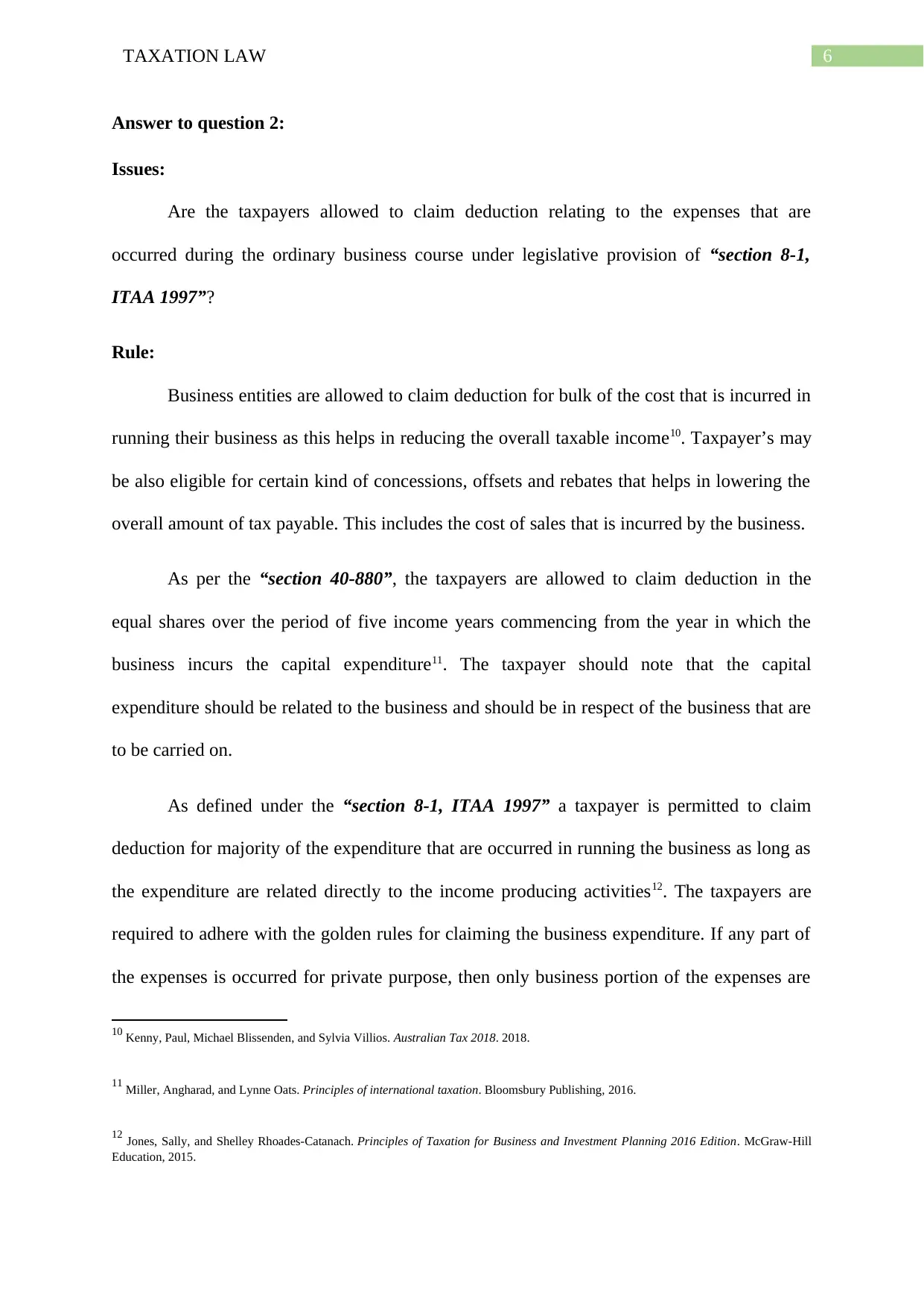
6TAXATION LAW
Answer to question 2:
Issues:
Are the taxpayers allowed to claim deduction relating to the expenses that are
occurred during the ordinary business course under legislative provision of “section 8-1,
ITAA 1997”?
Rule:
Business entities are allowed to claim deduction for bulk of the cost that is incurred in
running their business as this helps in reducing the overall taxable income10. Taxpayer’s may
be also eligible for certain kind of concessions, offsets and rebates that helps in lowering the
overall amount of tax payable. This includes the cost of sales that is incurred by the business.
As per the “section 40-880”, the taxpayers are allowed to claim deduction in the
equal shares over the period of five income years commencing from the year in which the
business incurs the capital expenditure11. The taxpayer should note that the capital
expenditure should be related to the business and should be in respect of the business that are
to be carried on.
As defined under the “section 8-1, ITAA 1997” a taxpayer is permitted to claim
deduction for majority of the expenditure that are occurred in running the business as long as
the expenditure are related directly to the income producing activities12. The taxpayers are
required to adhere with the golden rules for claiming the business expenditure. If any part of
the expenses is occurred for private purpose, then only business portion of the expenses are
10 Kenny, Paul, Michael Blissenden, and Sylvia Villios. Australian Tax 2018. 2018.
11 Miller, Angharad, and Lynne Oats. Principles of international taxation. Bloomsbury Publishing, 2016.
12 Jones, Sally, and Shelley Rhoades-Catanach. Principles of Taxation for Business and Investment Planning 2016 Edition. McGraw-Hill
Education, 2015.
Answer to question 2:
Issues:
Are the taxpayers allowed to claim deduction relating to the expenses that are
occurred during the ordinary business course under legislative provision of “section 8-1,
ITAA 1997”?
Rule:
Business entities are allowed to claim deduction for bulk of the cost that is incurred in
running their business as this helps in reducing the overall taxable income10. Taxpayer’s may
be also eligible for certain kind of concessions, offsets and rebates that helps in lowering the
overall amount of tax payable. This includes the cost of sales that is incurred by the business.
As per the “section 40-880”, the taxpayers are allowed to claim deduction in the
equal shares over the period of five income years commencing from the year in which the
business incurs the capital expenditure11. The taxpayer should note that the capital
expenditure should be related to the business and should be in respect of the business that are
to be carried on.
As defined under the “section 8-1, ITAA 1997” a taxpayer is permitted to claim
deduction for majority of the expenditure that are occurred in running the business as long as
the expenditure are related directly to the income producing activities12. The taxpayers are
required to adhere with the golden rules for claiming the business expenditure. If any part of
the expenses is occurred for private purpose, then only business portion of the expenses are
10 Kenny, Paul, Michael Blissenden, and Sylvia Villios. Australian Tax 2018. 2018.
11 Miller, Angharad, and Lynne Oats. Principles of international taxation. Bloomsbury Publishing, 2016.
12 Jones, Sally, and Shelley Rhoades-Catanach. Principles of Taxation for Business and Investment Planning 2016 Edition. McGraw-Hill
Education, 2015.
Paraphrase This Document
Need a fresh take? Get an instant paraphrase of this document with our AI Paraphraser
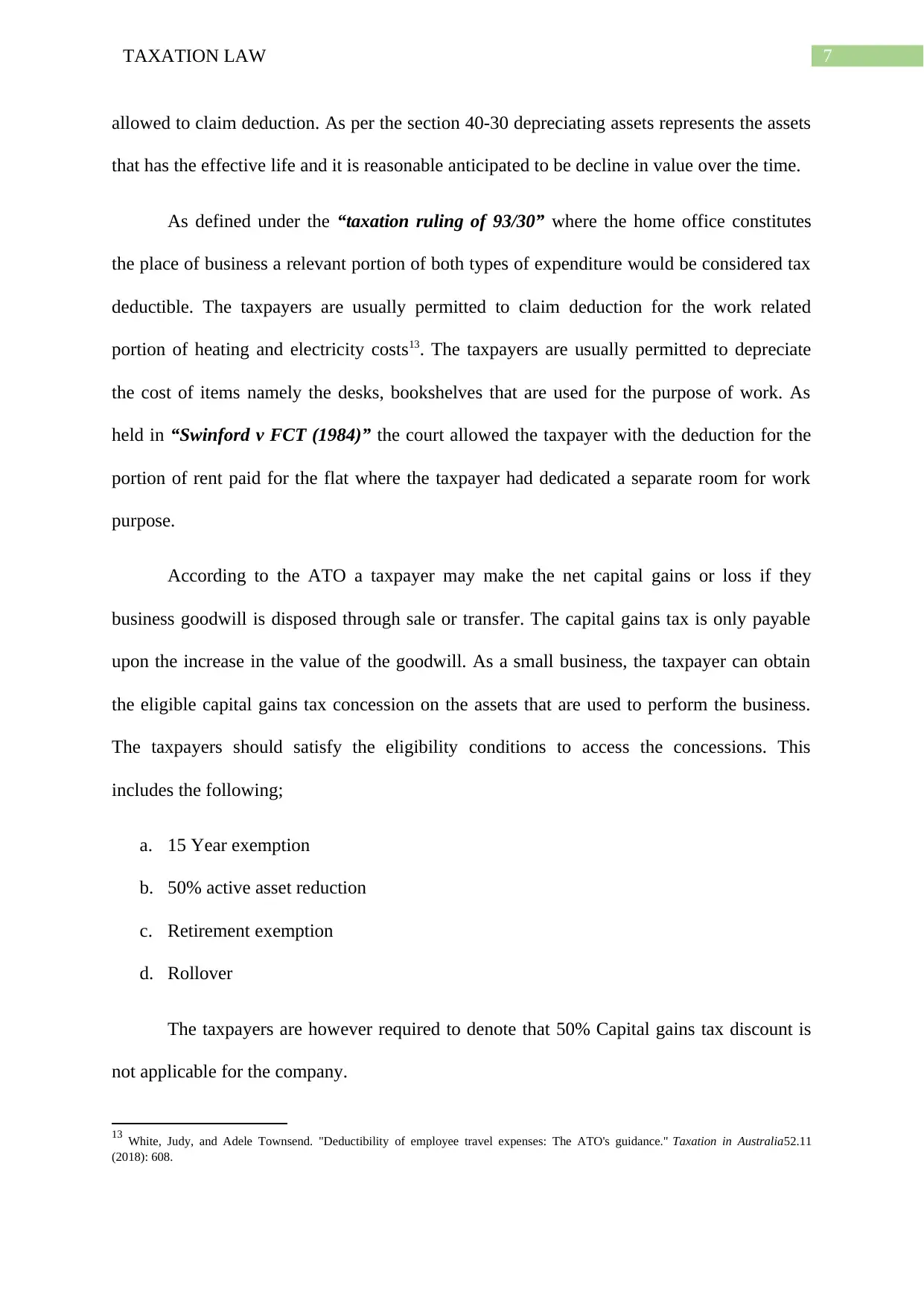
7TAXATION LAW
allowed to claim deduction. As per the section 40-30 depreciating assets represents the assets
that has the effective life and it is reasonable anticipated to be decline in value over the time.
As defined under the “taxation ruling of 93/30” where the home office constitutes
the place of business a relevant portion of both types of expenditure would be considered tax
deductible. The taxpayers are usually permitted to claim deduction for the work related
portion of heating and electricity costs13. The taxpayers are usually permitted to depreciate
the cost of items namely the desks, bookshelves that are used for the purpose of work. As
held in “Swinford v FCT (1984)” the court allowed the taxpayer with the deduction for the
portion of rent paid for the flat where the taxpayer had dedicated a separate room for work
purpose.
According to the ATO a taxpayer may make the net capital gains or loss if they
business goodwill is disposed through sale or transfer. The capital gains tax is only payable
upon the increase in the value of the goodwill. As a small business, the taxpayer can obtain
the eligible capital gains tax concession on the assets that are used to perform the business.
The taxpayers should satisfy the eligibility conditions to access the concessions. This
includes the following;
a. 15 Year exemption
b. 50% active asset reduction
c. Retirement exemption
d. Rollover
The taxpayers are however required to denote that 50% Capital gains tax discount is
not applicable for the company.
13 White, Judy, and Adele Townsend. "Deductibility of employee travel expenses: The ATO's guidance." Taxation in Australia52.11
(2018): 608.
allowed to claim deduction. As per the section 40-30 depreciating assets represents the assets
that has the effective life and it is reasonable anticipated to be decline in value over the time.
As defined under the “taxation ruling of 93/30” where the home office constitutes
the place of business a relevant portion of both types of expenditure would be considered tax
deductible. The taxpayers are usually permitted to claim deduction for the work related
portion of heating and electricity costs13. The taxpayers are usually permitted to depreciate
the cost of items namely the desks, bookshelves that are used for the purpose of work. As
held in “Swinford v FCT (1984)” the court allowed the taxpayer with the deduction for the
portion of rent paid for the flat where the taxpayer had dedicated a separate room for work
purpose.
According to the ATO a taxpayer may make the net capital gains or loss if they
business goodwill is disposed through sale or transfer. The capital gains tax is only payable
upon the increase in the value of the goodwill. As a small business, the taxpayer can obtain
the eligible capital gains tax concession on the assets that are used to perform the business.
The taxpayers should satisfy the eligibility conditions to access the concessions. This
includes the following;
a. 15 Year exemption
b. 50% active asset reduction
c. Retirement exemption
d. Rollover
The taxpayers are however required to denote that 50% Capital gains tax discount is
not applicable for the company.
13 White, Judy, and Adele Townsend. "Deductibility of employee travel expenses: The ATO's guidance." Taxation in Australia52.11
(2018): 608.
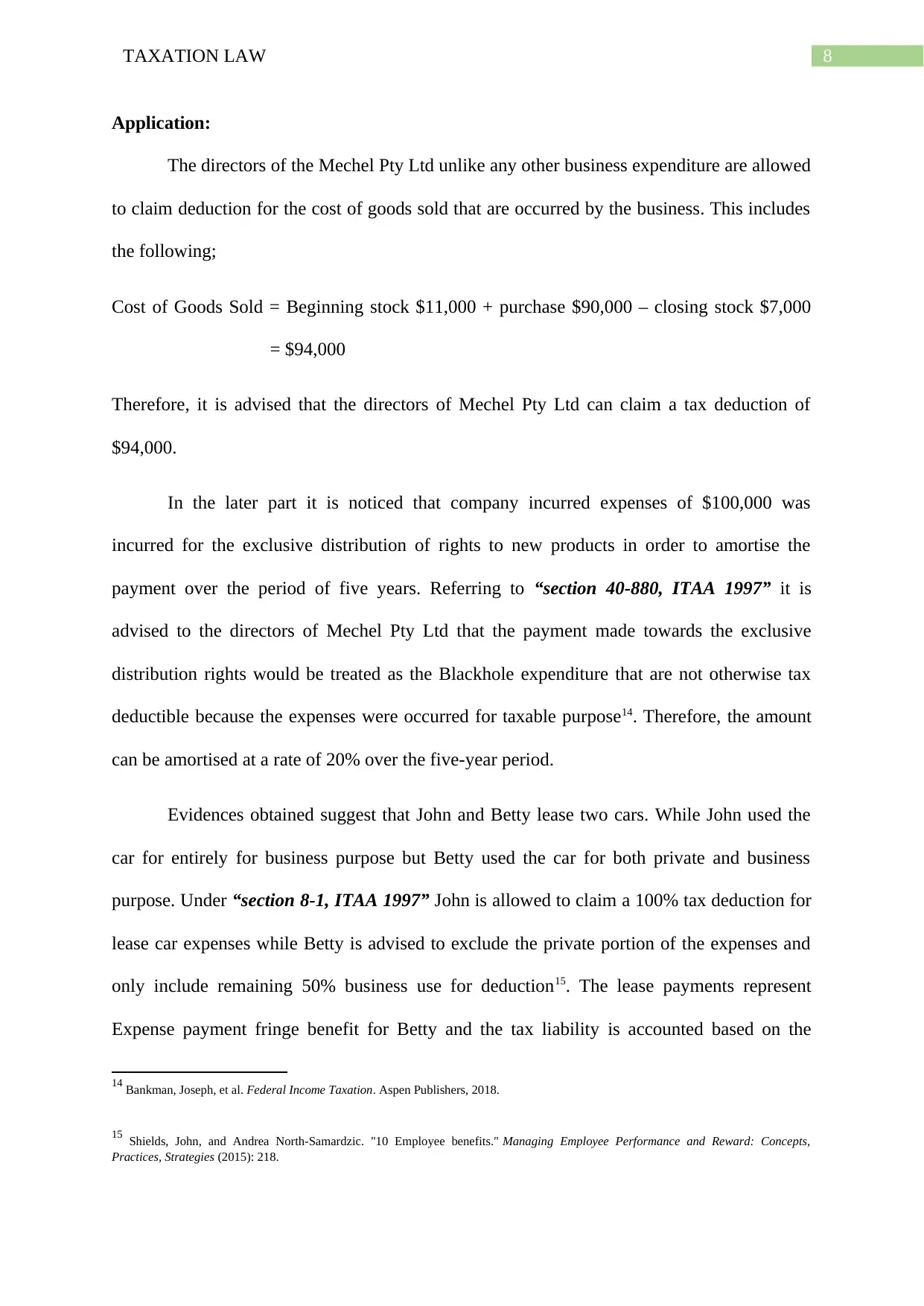
8TAXATION LAW
Application:
The directors of the Mechel Pty Ltd unlike any other business expenditure are allowed
to claim deduction for the cost of goods sold that are occurred by the business. This includes
the following;
Cost of Goods Sold = Beginning stock $11,000 + purchase $90,000 – closing stock $7,000
= $94,000
Therefore, it is advised that the directors of Mechel Pty Ltd can claim a tax deduction of
$94,000.
In the later part it is noticed that company incurred expenses of $100,000 was
incurred for the exclusive distribution of rights to new products in order to amortise the
payment over the period of five years. Referring to “section 40-880, ITAA 1997” it is
advised to the directors of Mechel Pty Ltd that the payment made towards the exclusive
distribution rights would be treated as the Blackhole expenditure that are not otherwise tax
deductible because the expenses were occurred for taxable purpose14. Therefore, the amount
can be amortised at a rate of 20% over the five-year period.
Evidences obtained suggest that John and Betty lease two cars. While John used the
car for entirely for business purpose but Betty used the car for both private and business
purpose. Under “section 8-1, ITAA 1997” John is allowed to claim a 100% tax deduction for
lease car expenses while Betty is advised to exclude the private portion of the expenses and
only include remaining 50% business use for deduction15. The lease payments represent
Expense payment fringe benefit for Betty and the tax liability is accounted based on the
14 Bankman, Joseph, et al. Federal Income Taxation. Aspen Publishers, 2018.
15 Shields, John, and Andrea North-Samardzic. "10 Employee benefits." Managing Employee Performance and Reward: Concepts,
Practices, Strategies (2015): 218.
Application:
The directors of the Mechel Pty Ltd unlike any other business expenditure are allowed
to claim deduction for the cost of goods sold that are occurred by the business. This includes
the following;
Cost of Goods Sold = Beginning stock $11,000 + purchase $90,000 – closing stock $7,000
= $94,000
Therefore, it is advised that the directors of Mechel Pty Ltd can claim a tax deduction of
$94,000.
In the later part it is noticed that company incurred expenses of $100,000 was
incurred for the exclusive distribution of rights to new products in order to amortise the
payment over the period of five years. Referring to “section 40-880, ITAA 1997” it is
advised to the directors of Mechel Pty Ltd that the payment made towards the exclusive
distribution rights would be treated as the Blackhole expenditure that are not otherwise tax
deductible because the expenses were occurred for taxable purpose14. Therefore, the amount
can be amortised at a rate of 20% over the five-year period.
Evidences obtained suggest that John and Betty lease two cars. While John used the
car for entirely for business purpose but Betty used the car for both private and business
purpose. Under “section 8-1, ITAA 1997” John is allowed to claim a 100% tax deduction for
lease car expenses while Betty is advised to exclude the private portion of the expenses and
only include remaining 50% business use for deduction15. The lease payments represent
Expense payment fringe benefit for Betty and the tax liability is accounted based on the
14 Bankman, Joseph, et al. Federal Income Taxation. Aspen Publishers, 2018.
15 Shields, John, and Andrea North-Samardzic. "10 Employee benefits." Managing Employee Performance and Reward: Concepts,
Practices, Strategies (2015): 218.
⊘ This is a preview!⊘
Do you want full access?
Subscribe today to unlock all pages.

Trusted by 1+ million students worldwide
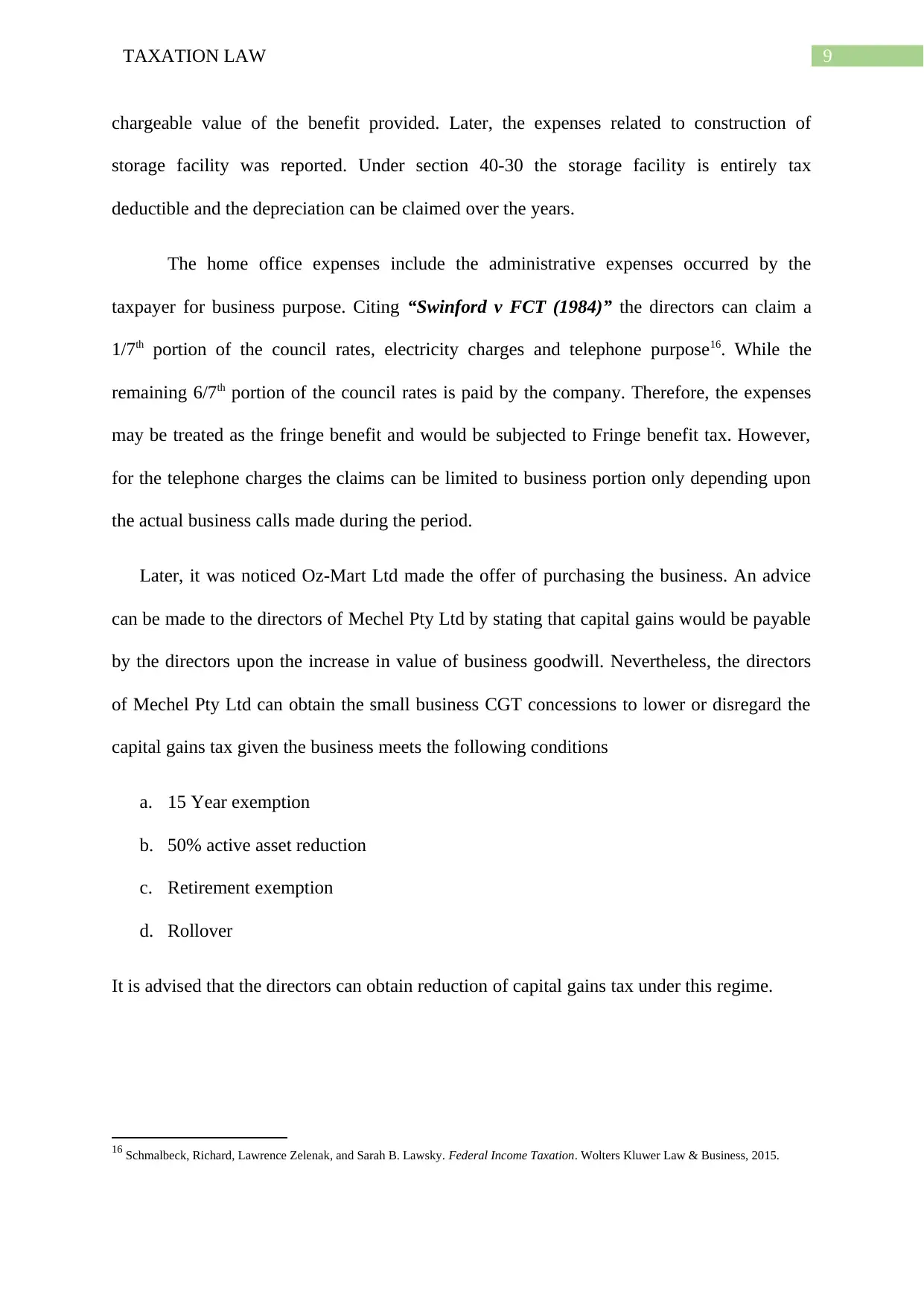
9TAXATION LAW
chargeable value of the benefit provided. Later, the expenses related to construction of
storage facility was reported. Under section 40-30 the storage facility is entirely tax
deductible and the depreciation can be claimed over the years.
The home office expenses include the administrative expenses occurred by the
taxpayer for business purpose. Citing “Swinford v FCT (1984)” the directors can claim a
1/7th portion of the council rates, electricity charges and telephone purpose16. While the
remaining 6/7th portion of the council rates is paid by the company. Therefore, the expenses
may be treated as the fringe benefit and would be subjected to Fringe benefit tax. However,
for the telephone charges the claims can be limited to business portion only depending upon
the actual business calls made during the period.
Later, it was noticed Oz-Mart Ltd made the offer of purchasing the business. An advice
can be made to the directors of Mechel Pty Ltd by stating that capital gains would be payable
by the directors upon the increase in value of business goodwill. Nevertheless, the directors
of Mechel Pty Ltd can obtain the small business CGT concessions to lower or disregard the
capital gains tax given the business meets the following conditions
a. 15 Year exemption
b. 50% active asset reduction
c. Retirement exemption
d. Rollover
It is advised that the directors can obtain reduction of capital gains tax under this regime.
16 Schmalbeck, Richard, Lawrence Zelenak, and Sarah B. Lawsky. Federal Income Taxation. Wolters Kluwer Law & Business, 2015.
chargeable value of the benefit provided. Later, the expenses related to construction of
storage facility was reported. Under section 40-30 the storage facility is entirely tax
deductible and the depreciation can be claimed over the years.
The home office expenses include the administrative expenses occurred by the
taxpayer for business purpose. Citing “Swinford v FCT (1984)” the directors can claim a
1/7th portion of the council rates, electricity charges and telephone purpose16. While the
remaining 6/7th portion of the council rates is paid by the company. Therefore, the expenses
may be treated as the fringe benefit and would be subjected to Fringe benefit tax. However,
for the telephone charges the claims can be limited to business portion only depending upon
the actual business calls made during the period.
Later, it was noticed Oz-Mart Ltd made the offer of purchasing the business. An advice
can be made to the directors of Mechel Pty Ltd by stating that capital gains would be payable
by the directors upon the increase in value of business goodwill. Nevertheless, the directors
of Mechel Pty Ltd can obtain the small business CGT concessions to lower or disregard the
capital gains tax given the business meets the following conditions
a. 15 Year exemption
b. 50% active asset reduction
c. Retirement exemption
d. Rollover
It is advised that the directors can obtain reduction of capital gains tax under this regime.
16 Schmalbeck, Richard, Lawrence Zelenak, and Sarah B. Lawsky. Federal Income Taxation. Wolters Kluwer Law & Business, 2015.
Paraphrase This Document
Need a fresh take? Get an instant paraphrase of this document with our AI Paraphraser
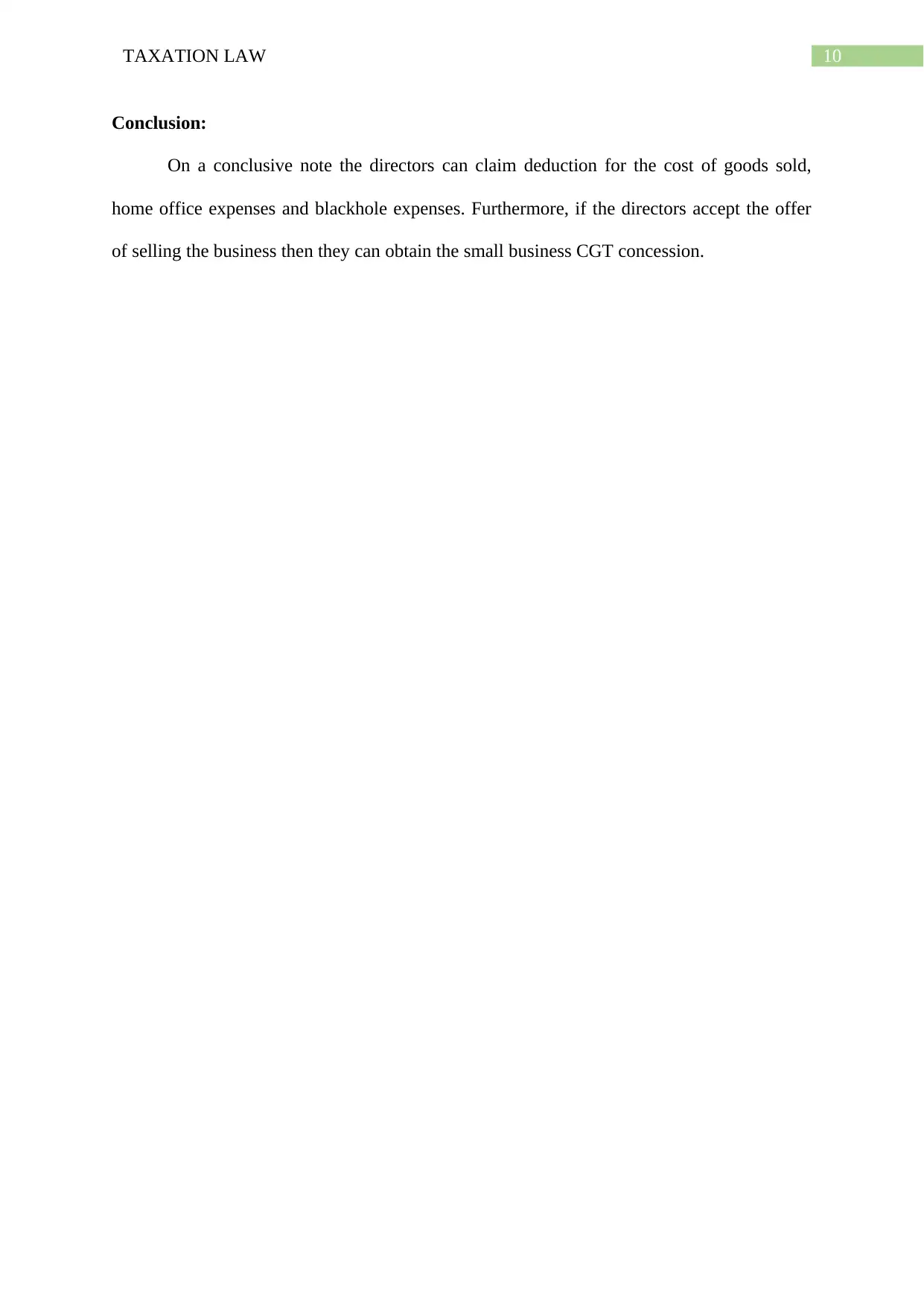
10TAXATION LAW
Conclusion:
On a conclusive note the directors can claim deduction for the cost of goods sold,
home office expenses and blackhole expenses. Furthermore, if the directors accept the offer
of selling the business then they can obtain the small business CGT concession.
Conclusion:
On a conclusive note the directors can claim deduction for the cost of goods sold,
home office expenses and blackhole expenses. Furthermore, if the directors accept the offer
of selling the business then they can obtain the small business CGT concession.
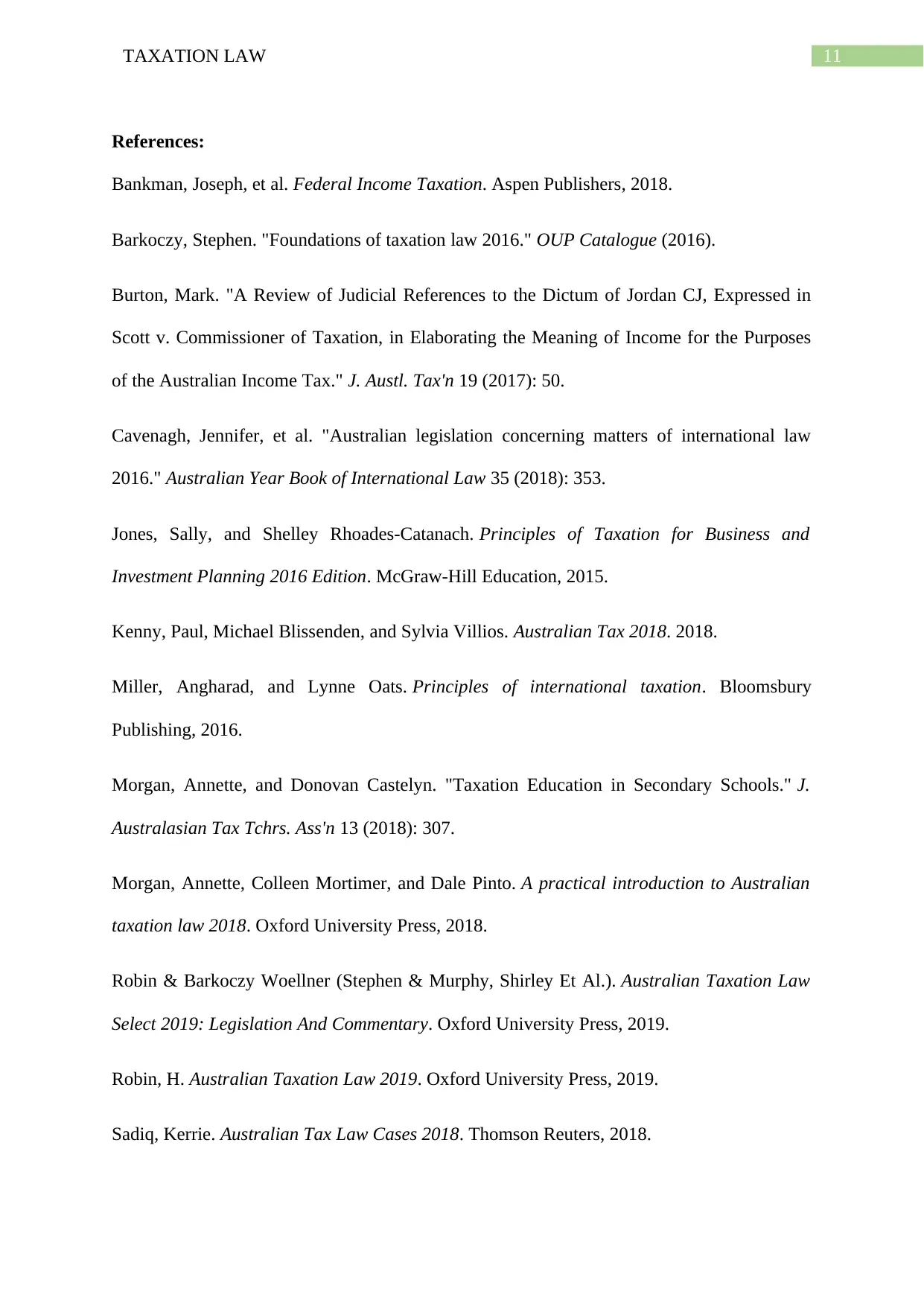
11TAXATION LAW
References:
Bankman, Joseph, et al. Federal Income Taxation. Aspen Publishers, 2018.
Barkoczy, Stephen. "Foundations of taxation law 2016." OUP Catalogue (2016).
Burton, Mark. "A Review of Judicial References to the Dictum of Jordan CJ, Expressed in
Scott v. Commissioner of Taxation, in Elaborating the Meaning of Income for the Purposes
of the Australian Income Tax." J. Austl. Tax'n 19 (2017): 50.
Cavenagh, Jennifer, et al. "Australian legislation concerning matters of international law
2016." Australian Year Book of International Law 35 (2018): 353.
Jones, Sally, and Shelley Rhoades-Catanach. Principles of Taxation for Business and
Investment Planning 2016 Edition. McGraw-Hill Education, 2015.
Kenny, Paul, Michael Blissenden, and Sylvia Villios. Australian Tax 2018. 2018.
Miller, Angharad, and Lynne Oats. Principles of international taxation. Bloomsbury
Publishing, 2016.
Morgan, Annette, and Donovan Castelyn. "Taxation Education in Secondary Schools." J.
Australasian Tax Tchrs. Ass'n 13 (2018): 307.
Morgan, Annette, Colleen Mortimer, and Dale Pinto. A practical introduction to Australian
taxation law 2018. Oxford University Press, 2018.
Robin & Barkoczy Woellner (Stephen & Murphy, Shirley Et Al.). Australian Taxation Law
Select 2019: Legislation And Commentary. Oxford University Press, 2019.
Robin, H. Australian Taxation Law 2019. Oxford University Press, 2019.
Sadiq, Kerrie. Australian Tax Law Cases 2018. Thomson Reuters, 2018.
References:
Bankman, Joseph, et al. Federal Income Taxation. Aspen Publishers, 2018.
Barkoczy, Stephen. "Foundations of taxation law 2016." OUP Catalogue (2016).
Burton, Mark. "A Review of Judicial References to the Dictum of Jordan CJ, Expressed in
Scott v. Commissioner of Taxation, in Elaborating the Meaning of Income for the Purposes
of the Australian Income Tax." J. Austl. Tax'n 19 (2017): 50.
Cavenagh, Jennifer, et al. "Australian legislation concerning matters of international law
2016." Australian Year Book of International Law 35 (2018): 353.
Jones, Sally, and Shelley Rhoades-Catanach. Principles of Taxation for Business and
Investment Planning 2016 Edition. McGraw-Hill Education, 2015.
Kenny, Paul, Michael Blissenden, and Sylvia Villios. Australian Tax 2018. 2018.
Miller, Angharad, and Lynne Oats. Principles of international taxation. Bloomsbury
Publishing, 2016.
Morgan, Annette, and Donovan Castelyn. "Taxation Education in Secondary Schools." J.
Australasian Tax Tchrs. Ass'n 13 (2018): 307.
Morgan, Annette, Colleen Mortimer, and Dale Pinto. A practical introduction to Australian
taxation law 2018. Oxford University Press, 2018.
Robin & Barkoczy Woellner (Stephen & Murphy, Shirley Et Al.). Australian Taxation Law
Select 2019: Legislation And Commentary. Oxford University Press, 2019.
Robin, H. Australian Taxation Law 2019. Oxford University Press, 2019.
Sadiq, Kerrie. Australian Tax Law Cases 2018. Thomson Reuters, 2018.
⊘ This is a preview!⊘
Do you want full access?
Subscribe today to unlock all pages.

Trusted by 1+ million students worldwide
1 out of 13
Related Documents
Your All-in-One AI-Powered Toolkit for Academic Success.
+13062052269
info@desklib.com
Available 24*7 on WhatsApp / Email
![[object Object]](/_next/static/media/star-bottom.7253800d.svg)
Unlock your academic potential
Copyright © 2020–2025 A2Z Services. All Rights Reserved. Developed and managed by ZUCOL.





